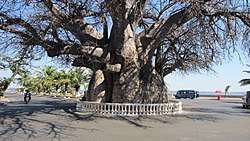Adansonia digitata
Adansonia digitata, the African baobab, is the most widespread tree species of the genus Adansonia, the baobabs, and is native to the African continent.[2][3][4] The long-lived pachycauls are typically found in dry, hot savannahs of sub-Saharan Africa, where they dominate the landscape, and reveal the presence of a watercourse from afar.[5] Their growth rate is determined by ground water or rainfall,[6][7] and their maximum age, which is subject to much conjecture, seems to be in the order of 1,500 years.[8] They have traditionally been valued as sources of food, water, health remedies or places of shelter and are steeped in legend and superstition.[6] European explorers of old were inclined to carve their names on baobabs, and many are defaced by modern graffiti.[5]
| African baobab | |
|---|---|
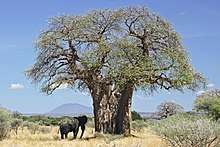 | |
| Mature, flowering tree in Tanzania | |
| Scientific classification | |
| Kingdom: | Plantae |
| Clade: | Tracheophytes |
| Clade: | Angiosperms |
| Clade: | Eudicots |
| Clade: | Rosids |
| Order: | Malvales |
| Family: | Malvaceae |
| Genus: | Adansonia |
| Species: | A. digitata |
| Binomial name | |
| Adansonia digitata | |
| Synonyms[1] | |
| |
Naming and description
The scientific name Adansonia refers to the French explorer and botanist, Michel Adanson (1727–1806), who observed a specimen in 1749 on the island of Sor, Senegal.[9] On the nearby Îles des Madeleines Adanson found another baobab, 3.8 metres (12 ft) in diameter, which bore the carvings of passing mariners on its trunk, including those of Henry the Navigator in 1444 and André Thevet in 1555.[5] When Théodore Monod searched the island in the 20th century, this tree was not to be found. Adanson concluded that the baobab, of all the trees he studied, "is probably the most useful tree in all." He consumed baobab juice twice a day while in Africa, and was convinced that it maintained his health.[10] "Digitata" refers to the digits of the hand, as the baobab has compound leaves with normally five (but up to seven) leaflets are akin to a hand.[11]
Common names for the baobab include monkey-bread tree (the soft, dry fruit is edible), upside-down tree (the sparse branches resemble roots), and cream of tartar tree (cream of tartar).[12]
Habit and physical description
_in_Hyderabad_W_IMG_8271.jpg)
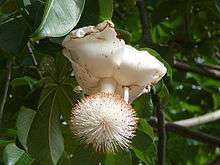
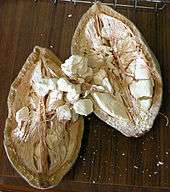
The trees usually grow as solitary individuals, and are large and distinctive elements of savannah or scrubland vegetation. Some large individuals live to well over a thousand years of age.[13] All baobab trees are deciduous, losing their leaves in the dry season, and remain leafless for eight months of the year.
They can grow to between 5–25 m (16–82 ft) in height. They are in fact known both for their height and trunk's girth. The trunk tends to be bottle-shaped and can reach a diameter of 10–14 m (33–46 ft).[14] The span of the roots actually exceed the tree's height, a factor that enables it to survive in a dry climate. Many consider the tree to be “upside-down” due to the trunk likeness to a taproot and the branches akin to finer capillary roots. The trunk is smooth and shiny[15] and can range from being reddish brown to grey. The bark can feel cork-like.[10] The branches are thick and wide and very stout compared to the trunk.
During the early summer (October to December in southern hemisphere)[16] the tree bears very large, heavy, white flowers. These are 12 cm (4.7 in) across and open during the late afternoon to stay open for one night.[6][14] The pendulous, showy flowers have a very large number of stamens. They have a sweet scent but later emit a carrion smell, especially when they turn brown and fall after 24 hours.[6][14] Researchers have shown that they appear to be primarily pollinated by fruit bats of the subfamily Pteropodinae. The flowers have 5 petals that are leathery and hairy on the inside. The sepals are cup-shaped and 5-cleft. The stamens are divided into multiple anthers and styles are 7-10 rayed.
The indehiscent fruit are large, egg-shaped capsules.[6] They are filled with pulp that dries, hardens, and falls to pieces which look like chunks of powdery, dry bread.[17] The seeds are hard, black and kidney-shaped.[6]
Range
They are native to mainland Africa.[2] The tree has also been introduced to other regions such as Australia and Asia.[2][3][4] The northern limit of its distribution in Africa is associated with rainfall patterns; only on the Atlantic coast and in the Sudanian Savanna does its occurrence venture naturally into the Sahel. On the Atlantic coast, this may be due to spreading after cultivation. Its occurrence is very limited in Central Africa, and it is found only in the very north of South Africa. In Eastern Africa, the trees grow also in shrublands and on the coast. In Angola and Namibia, the baobabs grow in woodlands, and in coastal regions, in addition to savannahs. [18] and in Penang, Malaysia, along certain streets.[19]
The baobab is native to most of Africa, especially in drier, less tropical climates. It is not found in areas where sand is deep. It is sensitive to water logging and frost.[20] More specifically: Mauritania, Senegal, Guinea, Sierra Leone, Mali, Burkina Faso, Ghana, Togo, Benin, Niger, Nigeria, northern Cameroon, Chad, Sudan, Congo Republic, DR Congo (formerly Zaire), Eritrea, Ethiopia, southern Somalia, Kenya, Tanzania, Zambia, Zimbabwe, Malawi, Mozambique, Angola, São Tomé, Príncipe, Annobon, Java (introduced), Nepal (introduced), Sri Lanka (introduced), Philippines (introduced), Jamaica (introduced), South Africa (Transvaal), Namibia, Botswana, Puerto Rico (introduced), Haiti (introduced), Dominican Republic (introduced), Venezuela (introduced), Seychelles (introduced), Madagascar (introduced), Comoros (introduced), India (introduced), southwest Yemen (introduced), Oman (Dhofar) (introduced), Guangdong (introduced), Fujian (introduced), Yunnan (introduced).[21]
Longevity
Adansonia trees produce faint growth rings, probably annually, but they are not reliable for aging specimens, because they are difficult to count and may fade away as the wood ages. Radiocarbon dating has provided data on a few individuals of A. digitata. The Panke baobab in Zimbabwe was some 2,450 years old when it died in 2011, making it the oldest angiosperm ever documented, and two other trees — Dorslandboom in Namibia and Glencoe in South Africa — were estimated to be approximately 2,000 years old.[22] Another specimen known as Grootboom was dated after it died and found to be at least 1275 years old.[23][24] Greenhouse gases, climate change, and global warming appear to be factors reducing baobab longevity.[25]
Food

The baobab is a traditional food plant in Africa, but is little-known elsewhere. The fruit has been suggested to have the potential to improve nutrition, boost food security, foster rural development, and support sustainable land care.[26]
Fruit
.jpg)

The African baobab fruit is usually 15–20 cm (6–8 in) long, but can be as big as 25 centimetres (9.8 in). In Sudan — where the tree is called tebeldi — people make tabaldi juice by soaking and dissolving the dry pulp of the fruit in water, locally known as gunguleiz.[27]
Leaves and seed
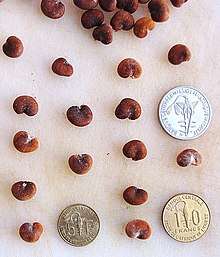
Baobab leaves can be eaten as a relish. Young fresh leaves are cooked in a sauce and sometimes are dried and powdered. The powder is called lalo in Mali and sold in many village markets in Western Africa. The leaves are used in the preparation of a soup termed miyan kuka in Northern Nigeria and are rich in phytochemicals and minerals.[28] Oil extracted by pounding the seeds can be used for cooking but this is not widespread.[29]
Baobab leaves are sometimes used as forage for ruminants in dry season. The oilmeal, which is a byproduct of oil extraction, can also be used as animal feed.[30] In times of drought, elephants consume the juicy wood beneath the bark of the baobab.[16]
For export
In 2008, the European Union approved the use and consumption of baobab fruit. It is commonly used as an ingredient in smoothies and cereal bars.[31] In 2009, the United States Food and Drug Administration (US FDA) granted generally recognized as safe (GRAS) status to baobab dried fruit pulp as a food ingredient.[32]
Variation and dispersal
In Africa, the different populations of baobabs have revealed significant genetic differences. It has consequently been suggested that the taxon contains more than one species. The shape of their fruit especially, varies considerably from region to region.[33]
Baobab seed withstand drying and remain viable over long periods, as it has a hard seed coat. It can potentially be dispersed over long distances, and its germination potential is improved when it has passed through the digestive tract of an animal. Animals like elephants, black rhinos and eland can potentially convey the seeds over long distances. Baboons likewise spread the seeds in their dung, but over shorter distances.[33]
Pollination in the baobab is achieved primarily by fruit bats, but bush babies and several kinds of insect also assist. Some aspects of the baobab's reproductive biology are not yet understood. It is still speculated whether fertile baobab seeds can result from pollination by the tree's own pollen. It would appear as if pollen from another tree is required for fertile seed, as isolated trees do form seed, only to abort them at a late stage. The existence of some very isolated trees, may then be due to their self-incompatibility and inability to reproduce.[33]
Arab traders introduced it to northwestern Madagascar. There they were often planted at the center of villages, and sometimes outlived them.[5]
Legends and myths
Along the Zambezi, the tribes believe that baobabs were upright and too proud. The gods became angry and uprooted them and threw them back into the ground upside-down. Evil spirits now cause bad luck to anyone that picks up the sweet white flowers. More specifically, a lion will kill them.[15] In Kafue National Park, one of the largest baobabs is known as “Kondanamwali” or the “tree that eats maidens.” The tree fell in love with four beautiful maidens. When they reached puberty, they made the tree jealous by finding husbands. So, one night, during a thunderstorm, the tree opened its trunk and took the maidens inside. A rest house has been built in the branches of the tree. On stormy nights, the crying of the imprisoned maidens can still be heard.[15] Some people believe that women living in kraals where baobabs are plenty will have more children. This is scientifically plausible as those women will have better access to the tree's vitamin-rich leaves and fruits to complement a vitamin-deficient diet.[15]
Cultural references
The tree also plays a role in Antoine De Saint-Exupéry’s fictional children’s book, The Little Prince. In the story, baobabs are described as dangerous plants which must be weeded out from the good plants, less they overcome a small planet and even break it to pieces.[35]
Conservation status and threats
As of April 2015 baobabs are not yet classified by the IUCN's Red List criteria, but they are a part of the “Catalogue of Life.”[21] The baobab is a protected tree in South Africa.[36] In the Sahel, the effects of drought, desertification and over-use of the fruit have been cited as causes for concern.[37]
Prominent specimens
A number of individual baobab trees attract sightseers due to either their age, size, specific history or isolated occurrence.
Around Gweta, Botswana, some have been declared national monuments. Green's Baobab, 27 km south of Gweta was inscribed by the 19th-century hunters and traders Frederick Thomas Green and Hendrik Matthys van Zyl besides other ruthless characters. Fred and Charles Green passed the baobab during an expedition to Lake Ngami and left the inscription "Green’s Expedition 1858–1859". An earlier inscription by an unknown traveller reads "1771".[38]
About 11 km south of Green's Baobab is the turn-off to Chapman's Baobab, also known as Seven Sisters or Xaugam, i.e. "lion's tail" in Tsoa. It was once an enormous multi-stemmed tree, used by passing explorers, traders and travellers as a navigation beacon. It guided them as they navigated the extensive salt pan northwards, while a hollow in the trunk served as a letterbox. The explorer and hunter James Chapman left an engraving on a large root when he passed the tree with artist Thomas Baines in 1861, but Livingstone, Oswell, Moffat and Selous also camped here. Livingstone supposedly carved a cross and his initials, and conveyed his 1853 sojourn in Missionary Travels, noting: "about two miles beyond [the immense saltpan Ntwetwe] we unyoked under a fine specimen of baobab, ... It consisted of 6 branches united into one trunk."[39] It had a circumference of 25 m before its constituent trunks collapsed outward on 7 January 2016. Not all its trunks are confirmed dead however,[40] one showing signs of life in 2019.[41]
Seven trees known as the Sleeping Sisters or Baines' Baobabs grow on a tiny islet in Kudiakam Pan, Botswana. They are named for Thomas Baines who painted them in May 1862, while en route to Victoria Falls. The fallen giant of Baines' day is still sprouting leaves (as of 2004), and a younger generation of trees are in evidence. The islet is accessible in winter when the pan is dry.[42]
The Ombalantu baobab in Namibia has a hollow trunk that can accommodate some 35 people. At times it has served as a chapel, post office, house, and a hiding site.
The Arbre de Brazza is a baobab in the Republic of the Congo under which de Brazza and his companions Dolisie, Chavannes and Ballay made a stop in 1877, as their engraving "EB 1887" still attests. Another engraving, "Mâ Prince", was left by president Nguesso in his youth.
At Saakpuli (also Sakpele) in northern Ghana the site of a 19th-century slave transit camp is marked by a stand of large baobabs, to which slaves were chained.[43] The chains were wrapped around their trunks or around the roots. Similarly, two trees at Salaga in central Ghana are reminders of the slave trade. One, located at the former slave market at the center of town, was replanted at the site of the original to which slaves were shackled. A second larger tree marks the slave cemetery, where bodies of dead slaves were dumped.
Inside the Golkonda fort in Hyderabad, India, is a baobab tree estimated to be 430 years old. It is the largest baobab outside of Africa.[44]
The Gouye Ndiouly or Guy Njulli (Wolof for "baobab of circumcision") may be the oldest baobab in Senegal and the northern hemisphere.[45] The partially collapsed tree from which new stems have emerged is situated near the bank of the Saloum River at Kahone. It was formerly the venue for the gàmmu, an annual festival during which the kingdom’s provincial rulers pledged their loyalty to the king.[46] From 1593 to 1939, 49 kings of the Guélewars dynasty were inducted at this tree. It was besides the place where the Buur Saloum organized circumcision ceremonies,[45][47] and in 1862 it became the scene of a battle.
The Grove Place Baobab, listed as a Champion Tree, is believed to be the oldest (250–300 years) of some 100 baobabs on Saint Croix in the US Virgin Islands. It is seen as a living testament to centuries of African presence, as the seeds were likely introduced by an African slave who arrived at the former estate during the 18th century. According to the bronze memorial plaque, twelve women were rounded up during the 1878 Fireburn labor riot, and burned alive beneath the tree. It has since been a rallying place for plantation laborers and unions.[48]
Some large specimens have been transplanted to new sites, as was the one at Cresta Mowana lodge in Kasane.[49]
| Notable extant specimens | ||
|---|---|---|
| Specimen | Location | Coordinate |
| Kumana Baobab | southern Kruger Park, South Africa | 24°37′06″S 31°47′13″E |
| Gannahoek Baobab | near Thabazimbi, South Africa | 24°26′17″S 27°08′47″E |
| Glencoe Baobab (2009 split) | near Hoedspruit, South Africa | 24°22′25″S 30°51′24″E |
| Briscoe's Baobab | central Kruger Park, South Africa | 24°02′39″S 31°51′40″E |
| Big Baobab Leydsdorp | Leydsdorp-Gravellotte, Limpopo, South Africa | 23°57′26″S 30°34′30″E |
| Von Wielligh's Baobab | central Kruger Park, South Africa | 23°56′27″S 31°43′05″E |
| Sunland Baobab (2016 & 2017 splits) | near Modjadjiskloof, South Africa | 23°37′16″S 30°11′53″E |
| Big Tree | in Blouberg Nature Reserve, South Africa | 22°59′48″S 29°04′20″E |
| Buffelsdrift Baobab | near Swartwater, South Africa | 22°51′41″S 28°13′30″E |
| Sagole Baobab | near Tshipise, South Africa | 22°30′00″S 30°38′00″E |
| Chapman's Baobab / Seven Sisters (2016 split) | Ntwetwe pan, south of Gweta, Botswana | 20°29′25″S 25°14′58″E |
| Blue Bay Baobab | Blue Bay, Mauritius | 20°25′53″S 57°42′57″E |
| Green's Baobab | 27 km south of Gweta, Botswana | 20°25′31″S 25°13′52″E |
| Baines' Baobabs / Sleeping Sisters | north of Gweta, Botswana | 20°06′44″S 24°46′09″E |
| Nxai Pan Baobab (western shore) | north of Gweta, Botswana | 19°53′46″S 24°43′15″E |
| Nxai Pan Baobabs | north of Gweta, Botswana | 19°52′42″S 24°47′21″E |
| Holboom | Naye-Naye Concession, Otjozondjupa Region, Namibia | 19°40′41″S 20°37′05″E |
| Dorslandboom | Mangetti, north of Tsumkwe, Namibia | 19°25′07″S 20°35′37″E |
| Giant Baobab Tree | Die Park, Otjozondjupa Region, Namibia | 18°53′10″S 18°19′38″E |
| Savuti Baobab Island | Savuti Plains, Chobe, Botswana | 18°32′19″S 24°06′28″E |
| Sinamatella Road Baobab | Hwange National Park, Zimbabwe | 18°31′51″S 26°24′53″E |
| Ngoma Bridge baobabs | Chobe Forest Reserve, Botswana | 17°55′34″S 24°43′09″E |
| Big Tree | near Victoria Falls, Zimbabwe | 17°54′45″S 25°50′28″E |
| Okahao Baobab | Okahao, Namibia | 17°53′38″S 15°03′59″E |
| Sir Howard's baobab | Tsandi, Namibia | 17°44′51″S 14°53′41″E |
| Ombalantu Baobab | Outapi, northern Namibia | 17°30′43″S 14°59′16″E |
| Hollow Mubuyu Tree | Katima Mulilo, Namibia | 17°29′19″S 24°16′42″E |
| Kondanamwali | Kafue N.P., Zambia | ca. 16°19′49″S 25°55′29″E |
| Mahajanga / Majunga baobab | Mahajanga, Madagascar | 15°43′17″S 46°18′18″E |
| Porto de Galinhas Baobabs | Porto de Galinhas, PE, Brazil | 08°30′04″S 35°00′31″W |
| Stanley's Baobab | Boma, DRC | 05°51′34″S 13°03′21″E |
| Poet's Boabab | Natal, RN, Brazil | 05°48′20″S 35°12′34″W |
| L'arbre de Brazza | near Dolisie, Niari, Republic of the Congo | 04°11′07″S 12°35′50″E |
| Mombasa Baobab Forest | Mombasa, Kenya | 04°04′42″S 39°40′01″E |
| Lugard's Baobab | near Lokoja, Nigeria | 07°49′11″N 06°44′07″E |
| Aliya-gaha / Elephant tree | Gangewadiya basin, Wilpattu N.P., Sri Lanka | ca. 8°17′41″N 79°50′50″E |
| Salaga slave market baobab | Salaga, Ghana | ca. 8°33′00″N 0°31′15″W |
| Salaga slave cemetery baobab | Salaga, Ghana | ca. 8°33′N 0°31′W |
| Pallimunai Baobab Tree | Pallimunai, Mannar District, Sri Lanka | 08°58′54″N 79°55′24″E |
| Delft Island baobab | Neduntheevu, Jaffna District, Sri Lanka | 09°30′45″N 79°42′55″E |
| Saakpuli slave camp baobabs | Saakpuli, near Pigu, Ghana | 10°01′27″N 0°46′02″W |
| Kuka Katsi | Durbi Takusheyi, Nigeria | 12°56′45″N 07°52′55″E |
| Gouye Ndiouly | Kahone, Kaolack Region, Senegal | ca. 14°08′37″N 16°00′27″W |
| Baak no Maad / King’s Baobab | Joal-Fadiouth, Thiès Region, Senegal | 14°09′12″N 16°49′25″W |
| Baobab Sacré | Fadial, Thiès Region, Senegal | 14°10′25″N 16°46′39″W |
| Dakfao sacred baobab | Dakfao, Niger | 14°12′03″N 03°16′11″E |
| Corniche Est baobab | East Corniche Road, Dakar, Senegal | 14°39′52″N 17°25′55″W |
| Savanur Baobabs | Savanur, India | 14°58′41″N 75°20′00″E |
| St. Maryam Dearit Shrine | near Keren, Eritrea | 15°47′40″N 38°28′06″E |
| João Barrosa Baobabs | João Barrosa, Boa Vista, Cape Verde | 16°01′08″N 22°44′31″W |
| Mirbat Baobab Forest | near Mirbat, Dhofar, Oman | 17°03′11″N 54°36′39″E |
| Hatiyan Jhad Baobab Tree | Naya Qila, Golconda Fort, Hyderabad, India | 17°23′34″N 78°24′39″E |
| Nanakramguda Baobab Tree | Nanakramguda, Hyderabad, India | 17°25′26″N 78°20′40″E |
| Grove Place Baobab | Grove Place, Saint Croix, US Virgin Islands | 17°43′34″N 64°49′28″W |
| Diu Rukhda Baobab | Diu Island, Nagao Beach, Gujarat, India | 20°42′16″N 70°54′18″E |
| Zaymi Baobab | Zaymi, Al Batinah, Oman | 24°27′16″N 56°16′41″E |
| Mallanimli Baobab | Orchha, Madhya Pradesh, India | 25°21′51″N 78°38′32″E |
| Parijaat Tree | Kintoor, Uttar Pradesh, India | 27°01′35″N 81°28′43″E |
- Baobab at the slave cemetery, Salaga. The white calico cloth indicates its spiritual significance.

- Without leaves in Tarangire National Park, Tanzania
References
- "Adansonia digitata L." The Plant List. Retrieved 21 November 2015.
- "Curious Kimberley: Scientists disagree how boab trees got to Australia from Africa and Madagascar - ABC News". www.abc.net.au. August 6, 2018.
- "The Baobab: Fun Facts About Africa's Tree of Life". TripSavvy.
- "The baobab, a Malagasy tree".
- Wickens, Gerald E.; Lowe, Pat (2008). The baobabs pachycauls of Africa, Madagascar and Australia. New York: Springer Science + Business Media, B.V. pp. 31–. ISBN 9781402064319.
- Hankey, Andrew (February 2004). "Adansonia digitata A L." PlantZAfrica.com. Retrieved 28 November 2015.
- Grové, Naas (November 2011). "Redaksionele Kommentaar" (PDF). Dendron (43): 14. Archived from the original (PDF) on 4 March 2016. Retrieved 25 November 2015.
- Woodborne, Stephan, Dr. "Dating Africa's giants reveals far more than just age". CSIR. Archived from the original on 2015-11-26. Retrieved 25 November 2015.
- "Michel Adanson - Poudre Baobab bio - acheter poudre baobab bio". baobab.com. Retrieved 17 May 2015.
- "The Baobab Tree". Powbab. Retrieved 21 November 2015.
- du Plessis, Doep (November 2011). "Die Thabazimbi-bosveld se groot kremetart" (PDF). Dendron (43): 11. Archived from the original (PDF) on 4 March 2016. Retrieved 25 November 2015.
- "Monkey-bread tree (Adansonia digitata) | spotwild". spotwild.org. Retrieved 2020-05-29.
- Varmah, J. C.; Vaid, K. M. (1978). "Baobab - the historic African tree at Allahbad". Indian Forester. 104 (7): 461–464.
- "Baobab (Adansonia digitata) - Information on Baobab - Encyclopedia of Life". Encyclopedia of Life. Retrieved 17 May 2015.
- "Boabab Tree - Southern African Trees - Adansonia digitata". krugerpark.co.za. Retrieved 17 May 2015.
- Sheehan, Sean (2004). Zimbabwe (Vol. 6 of Cultures of the World) (2nd ed.). New York: Benchmark Books/Marshall Cavendish. p. 13. ISBN 9780761417064.
- National Research Council (January 25, 2008). "Baobab". Lost Crops of Africa: Volume III: Fruits. Lost Crops of Africa. 3. National Academies Press. doi:10.17226/11879. ISBN 978-0-309-10596-5. Retrieved July 15, 2008.
- "Adansonia digitata:Plant Database of India". Archived from the original on 26 August 2011. Retrieved 21 March 2011.
- Simon Gardner, Pindar Sidisunthorn and Lai Ee May, 2011. Heritage Trees of Penang. Penang: Areca Books. ISBN 978-967-57190-6-6
- "Descriptions and articles about the Baobab (Adansonia digitata) - Encyclopedia of Life". Encyclopedia of Life. Retrieved 17 May 2015.
- "Catalogue of Life - Adansonia digitata L." catalogueoflife.org. Retrieved 29 August 2017.
- Adrian Patrut et al. (2018) The demise of the largest and oldest African baobabs. Nature Plants 4: 423–426. DOI: 10.1038/s41477-018-0170-5
- Patrut, A., et al. (2010). Fire history of a giant African baobab evinced by radiocarbon dating. Archived 2014-10-22 at the Wayback Machine Radiocarbon 52(2), 717-26.
- "Adansonia digitata (baobab)". Royal Botanic Gardens, Kew. Archived from the original on 2014-02-20. Retrieved 2014-06-08.
- Ed Yong (11 June 2018). "Trees That Have Lived for Millennia Are Suddenly Dying The oldest baobabs are collapsing, and there's only one likely explanation". The Atlantic. Retrieved 12 June 2018.
- National Research Council (October 27, 2006). "Baobab". Lost Crops of Africa: Volume II: Vegetables. Lost Crops of Africa. 2. National Academies Press. doi:10.17226/11763. ISBN 978-0-309-10333-6. Retrieved July 15, 2008.
- Gebauer, J. (2013). "A note on baobab (Adansonia digitata L.) in Kordofan, Sudan". Genetic Resources and Crop Evolution. 60 (4): 1587–1596. doi:10.1007/s10722-013-9964-5. S2CID 6884609.
- Ogbaga, Chukwuma; Nuruddeen, Fatima; Alonge, Olatunbosun; Nwagbara, Onyinye (November 2017). "Phytochemical, elemental and proximate analyses of stored, sun-dried and shade-dried baobab (Adansonia digitata) leaves". 2017 13th International Conference on Electronics, Computer and Computation (ICECCO). pp. 1–5. doi:10.1109/ICECCO.2017.8333339. ISBN 978-1-5386-2499-9.
- Sidibe, M.; Williams, J. T. (2002). Baobab - Adansonia digitata (PDF). Southampton, UK: International Centre for Underutilised Crops. ISBN 978-0854327768. Archived from the original (PDF) on 2014-05-06. Retrieved 2012-07-31.
- Heuzé, V.; Tran, G.; Bastianelli, D.; Archimède, H. (January 25, 2013). "African baobab (Adansonia digitata)". Feedipedia.org. A programme by INRA, CIRAD, AFZ and FAO. Retrieved February 6, 2013.
- "Baobab dried fruit pulp". Advisory Committee on Novel Foods and Processes. 2008. Archived from the original on 2008-06-03.
- Laura M. Tarantino (July 25, 2009). "Agency Response Letter GRAS Notice No. GRN 000273". FDA.
- van Wyk, Braam, Prof. (November 2011). "Kommentaar oor die groot kremetart van Gannahoek" (PDF). Dendron (43): 14. Archived from the original (PDF) on 4 March 2016. Retrieved 25 November 2015.
- Sipa, Masika (2013). "The Old Baobab of Mahajanga". madamagazine.com. MadaMagazine. Retrieved 24 July 2017.
- Saint-Exupéry, Antoine (1943). Le Petit Prince [The Little Prince]. Reynal and Hitchcock.
- "Protected Trees" (PDF). Department of Water Affairs and Forestry, Republic of South Africa. 3 May 2013. Archived from the original (PDF) on 5 July 2010.
- Osman, Siham M. (2014). "Save the Baobab". practicalaction.org. ITDG Practical Action Sudan. Archived from the original on 2015-12-02. Retrieved 6 December 2015.
- "The Historic Baobabs in Botswana". discoverafrica.com. Retrieved 12 February 2020.
- Davidson, Julie (2012). Looking for Mrs Livingstone. Saint Andrew Press. p. 213. ISBN 9780715209646.
- "Chapman's Baobab – one of Africa's largest trees – falls". africageographic.com. Africa Geographic. 14 January 2016. Retrieved 12 April 2016.
- le Breton, Gus. "Is Chapman's Baobab Still Alive? Update from Botswana". African Plant Hunter. YouTube. Retrieved 11 February 2020.
- Watson, Rupert (2007). The African baobab. Cape Town: Struik. pp. 190–191. ISBN 9781770074309.
- Briggs, Philip (2014). Ghana: the Bradt travel guide (6 ed.). Chalfont St. Peter, Bucks: Bradt Travel Guides. p. 427. ISBN 9781841624785.
- Syed Akbar. "ASI conducts health check up of 430-year-old baobab tree of Golconda, says it's healthy". The Times of India. Retrieved 2019-04-15.
- Pătruţ, prof. dr. Adrian (project manager) (2015). "New research in dendrochronology and environmental climate change by using AMS/CFAMS radiocarbon dating and stable isotope analysis". chem.ubbcluj.ro. Retrieved 14 February 2020.
- Ross, Eric (25 January 2012). "Historic baobab trees of Senegal: Kahone". ericrossacademic.wordpress.com. Retrieved 14 February 2020.
- "Kahone, Ancienne capitale du Saloum: Passé-présent d'une ville pluricentenaire". sinesaloum.info. 7 November 2016. Retrieved 14 February 2020.
- "New St. Croix Park Celebrates the Legacy of the Baobab Tree". Repeating Islands. 20 May 2009. Retrieved 5 February 2020.
- Ashby, Alison (26 June 2013). "The baobab's secret". zambezitraveller.com. Retrieved 25 November 2015.
External links
| Wikimedia Commons has media related to Adansonia digitata. |
| Wikispecies has information related to Adansonia digitata |
- Description and cultural information
- Structured description
- PROTAbase on Adansonia digitata
- Feedipedia on Adansonia digitata
- Adansonia digitata in Brunken, U., Schmidt, M., Dressler, S., Janssen, T., Thiombiano, A. & Zizka, G. 2008. West African plants - A Photo Guide. www.westafricanplants.senckenberg.de.
